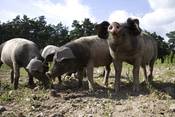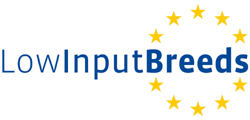Subproject 3: Pigs
Improving performance, animal health & welfare and product quality in organic and ‘low input’ PIG production systems
Responsible
- Dr. Jascha Leenhouwers, IPG
- Prof. Dr. Sandra Edwards, UNEW
 (Deputy)
(Deputy)
Workpackages
- WP3.1 Development of a "flower" breeding system to improve pig survival and robustness related traits in small populations; comparing the performance of breeds from ‘flower’ and conventional breeding systems.
- WP3.2 Effect of management innovations (gilt rearing and lactation systems) on mothering ability of sows as well as pre- and post-weaning diarrhoea and los-ses of piglets.
- WP3.3 Effect of traditional, improved and standard hybrid pig genotypes and feeding regimes on carcass, meat and fat quality in heavy pigs used for premium, regional pork products.
Contact
Dr. Jascha Leenhouwers
Institute for Pig Genetics BV
Schoenaker 6
6641 SZ Beuningen
The Netherlands
Tel. +31 24-6779999![]() E-mail
E-mail
www.ipg.nl ![]()
Pig production systems (subproject 3)
The aim of subproject 3 is to improve performance, animal health & welfare and product quality in organic and ‘low input’ PIG production systems.
Main issues
Main issues addressed under subproject 3 are:
1. Pig survival in outdoor, organic and free range production traits
 |
Pig survival and associated traits have been identified as main factors affecting the economic performance in outdoor, organic and free range production systems.
For example, piglet losses until weaning in organic systems may be as high as 20 percent compared to 12 percent on conventional farms. Genetic strategies to reduce pig losses and improve robustness are therefore a primary target of subproject 3.
2. Abiotic stress factors
Abiotic stress factors (in particular heat stress) are thought to result in significant reductions in both production efficiency and quality of meat and processed pork products.
While pigs raised in outdoor production systems may show increased resistance to certain diseases, they are often exposed to greater challenges by both abiotic (heat stress) and biotic (e.g. parasites) stress factors, that adversely affect food intake, health and performance of both breeding and growing pigs.
3. Nutritional and sensory quality of pig meat
Nutritional and sensory quality of pig meat may be affected by both the breed/genotype and dietary regimes.
Diets used in organic and other outdoor systems (e.g. higher forage intakes, lower ideal protein availability) may result in increased levels of nutritionally desirable omega-3 FA and antioxidants in pig fat and/or higher sensory quality of pork (e.g. higher levels of intramuscular fat).
However, the use of traditional breeds and organic diets with lower ideal protein availability may also increase carcass back-fat thickness.
The impact of (a) breed selection and (b) management practices on meat sensory and nutritional quality, but also (c) the potential for achieving higher carcass utilization rates from more robust, rare breeds via ‘added value’ specialist pork products (e.g. sausages and hams) will therefore also be investigated.
4. Lack of appropriate breeding infrastructure for the ‘low input’ sector
In conventional pig production, cross-breeding has been widely used since the 1970s to make use of heterosis, especially for vitality traits.
The size of the organic and ‘low input’ sector currently does not justify the investment into dedicated ‘cross-breeding’ infrastructures for the ‘low input’ sector. As a result most commercial ‘low input’ and organic pig producers use breeds, lines and crossbreds from conventional breeders/breeding programs. These genotypes have been selected under intensive production conditions and the breeding goals have included target traits which are important in intensive management systems, e.g. litter size, high lean tissue growth rate, efficient utilization of high nutrient density diets and low carcass backfat thickness.
To achieve progress with respect to priority traits (pig survival, product quality and environmental stress resistance) required by the organic and ‘low input’ sector it is therefore essential to develop specific breeding infrastructures, methods, and programs that are adapted to (a) the size of the sector and (b) its regulatory/standard requirements.
5. Economics of ‘low input’ pig production; the need to provide “added value”
Whilst the intensive production sector accounts for more than 95 percent of the pig industry in Europe, there has been a significant increase in demand for pork and pork products from organic and other ‘low input’ systems.
‘Low input’ pig production systems are usually characterized by smaller herd size, more space per animal, lower capital investment, often outdoor management, provision of bedding, greater labour requirement and focus on animal welfare. Organic pig production systems have similar characteristics to those described for ‘low input systems’ above. However, organic farming standards (a) prescribe low stocking densities and ac-cess to outdoor runs, (b) restrict the level of ‘bought in, non-organic’ feeds and (c) prohibit the use of GM-feeds, which usually results in higher management and feed costs and more limited dietary composition choices than in other ‘low input’ systems.
Management practices used in both ‘low input’ and particular organic systems, also result in higher production costs and make it necessary to achieve a price premium to maintain economic sustainability. The development of production systems which provide additional “nutritional”, “sensory”, “biodiversity”, “conservation” and/or “animal welfare” gains are therefore important to underpin current consumer perceptions about ‘added value’ quality characteristics of pork products from ‘low input’ production.
Work under subproject 3
Work under subproject 3 is subdivided into three main workpackages:
- WP3.1 Development of a ‘FLOWER’ BREEDING system to improve pig survival and robustness related traits in small populations; comparing the performance of breeds from ‘flower’ and conventional breeding systems.
- WP3.2 Effect of MANAGEMENT innovations (gilt rearing and lactation systems) on mothering ability of sows as well as pre- and post-weaning diarrhoea and losses of piglets.
- WP3.3 Effect of traditional, improved and standard hybrid PIG GENOTYPES and FEE-DING REGIMES on carcass, meat and fat quality in heavy pigs used for premium, regional pork products.
 This website was archived on December 19, 2017 and is no longer updated.
This website was archived on December 19, 2017 and is no longer updated.


